Ali Cheraghian
MoKD: Multi-Task Optimization for Knowledge Distillation
May 13, 2025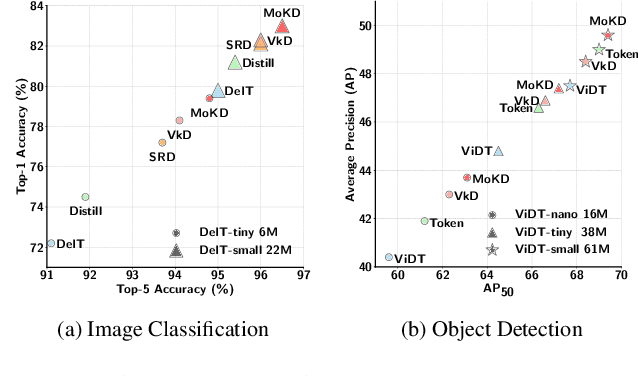
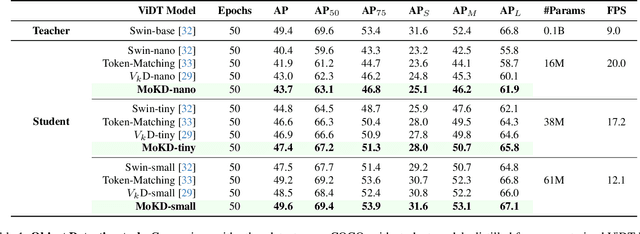
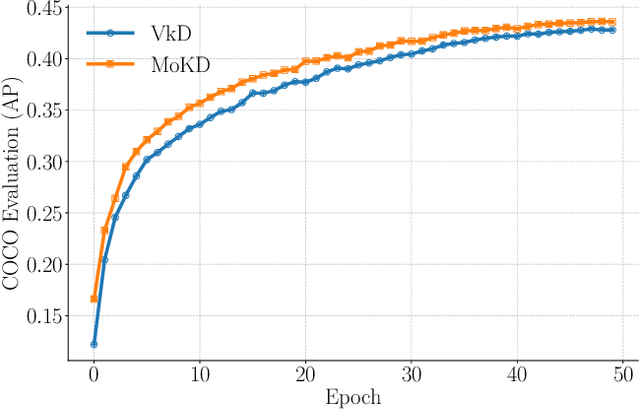
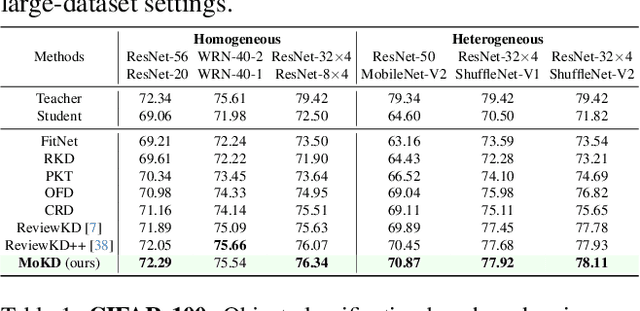
Abstract:Compact models can be effectively trained through Knowledge Distillation (KD), a technique that transfers knowledge from larger, high-performing teacher models. Two key challenges in Knowledge Distillation (KD) are: 1) balancing learning from the teacher's guidance and the task objective, and 2) handling the disparity in knowledge representation between teacher and student models. To address these, we propose Multi-Task Optimization for Knowledge Distillation (MoKD). MoKD tackles two main gradient issues: a) Gradient Conflicts, where task-specific and distillation gradients are misaligned, and b) Gradient Dominance, where one objective's gradient dominates, causing imbalance. MoKD reformulates KD as a multi-objective optimization problem, enabling better balance between objectives. Additionally, it introduces a subspace learning framework to project feature representations into a high-dimensional space, improving knowledge transfer. Our MoKD is demonstrated to outperform existing methods through extensive experiments on image classification using the ImageNet-1K dataset and object detection using the COCO dataset, achieving state-of-the-art performance with greater efficiency. To the best of our knowledge, MoKD models also achieve state-of-the-art performance compared to models trained from scratch.
Task Progressive Curriculum Learning for Robust Visual Question Answering
Nov 26, 2024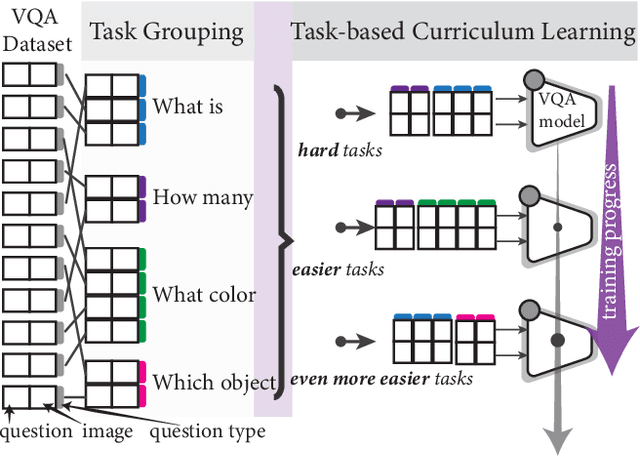
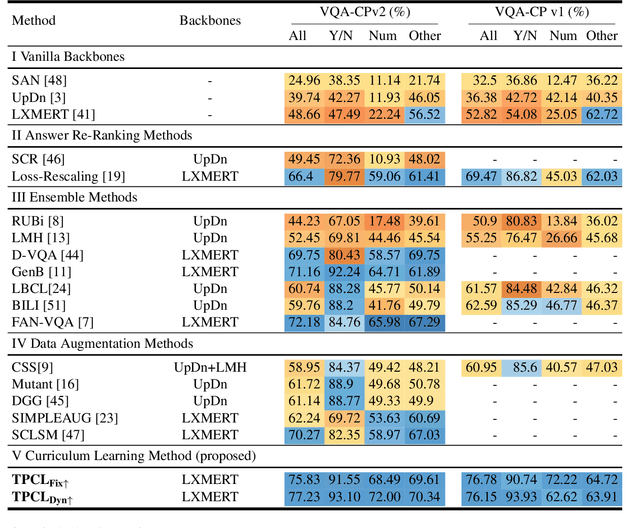
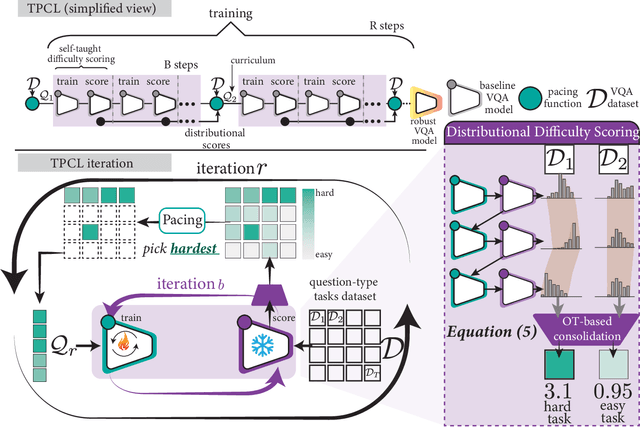
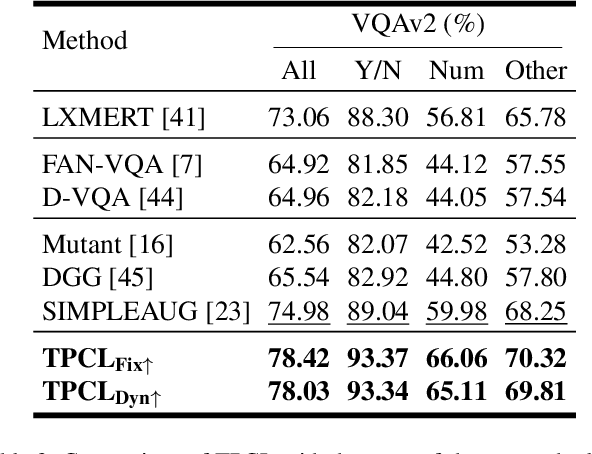
Abstract:Visual Question Answering (VQA) systems are known for their poor performance in out-of-distribution datasets. An issue that was addressed in previous works through ensemble learning, answer re-ranking, or artificially growing the training set. In this work, we show for the first time that robust Visual Question Answering is attainable by simply enhancing the training strategy. Our proposed approach, Task Progressive Curriculum Learning (TPCL), breaks the main VQA problem into smaller, easier tasks based on the question type. Then, it progressively trains the model on a (carefully crafted) sequence of tasks. We further support the method by a novel distributional-based difficulty measurer. Our approach is conceptually simple, model-agnostic, and easy to implement. We demonstrate TPCL effectiveness through a comprehensive evaluation on standard datasets. Without either data augmentation or explicit debiasing mechanism, it achieves state-of-the-art on VQA-CP v2, VQA-CP v1 and VQA v2 datasets. Extensive experiments demonstrate that TPCL outperforms the most competitive robust VQA approaches by more than 5% and 7% on VQA-CP v2 and VQA-CP v1; respectively. TPCL also can boost VQA baseline backbone performance by up to 28.5%.
Test-Time Adaptation of 3D Point Clouds via Denoising Diffusion Models
Nov 21, 2024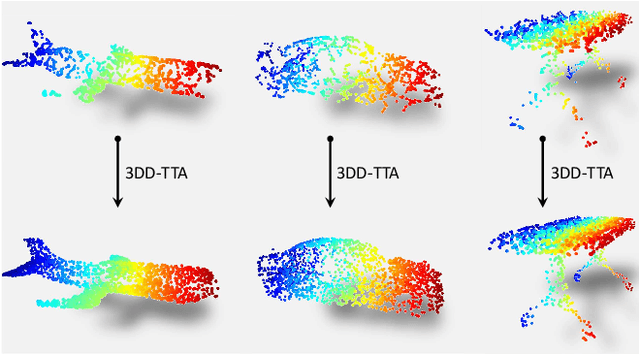



Abstract:Test-time adaptation (TTA) of 3D point clouds is crucial for mitigating discrepancies between training and testing samples in real-world scenarios, particularly when handling corrupted point clouds. LiDAR data, for instance, can be affected by sensor failures or environmental factors, causing domain gaps. Adapting models to these distribution shifts online is crucial, as training for every possible variation is impractical. Existing methods often focus on fine-tuning pre-trained models based on self-supervised learning or pseudo-labeling, which can lead to forgetting valuable source domain knowledge over time and reduce generalization on future tests. In this paper, we introduce a novel 3D test-time adaptation method, termed 3DD-TTA, which stands for 3D Denoising Diffusion Test-Time Adaptation. This method uses a diffusion strategy that adapts input point cloud samples to the source domain while keeping the source model parameters intact. The approach uses a Variational Autoencoder (VAE) to encode the corrupted point cloud into a shape latent and latent points. These latent points are corrupted with Gaussian noise and subjected to a denoising diffusion process. During this process, both the shape latent and latent points are updated to preserve fidelity, guiding the denoising toward generating consistent samples that align more closely with the source domain. We conduct extensive experiments on the ShapeNet dataset and investigate its generalizability on ModelNet40 and ScanObjectNN, achieving state-of-the-art results. The code has been released at \url{https://github.com/hamidreza-dastmalchi/3DD-TTA}.
Foundation Model-Powered 3D Few-Shot Class Incremental Learning via Training-free Adaptor
Oct 11, 2024Abstract:Recent advances in deep learning for processing point clouds hold increased interest in Few-Shot Class Incremental Learning (FSCIL) for 3D computer vision. This paper introduces a new method to tackle the Few-Shot Continual Incremental Learning (FSCIL) problem in 3D point cloud environments. We leverage a foundational 3D model trained extensively on point cloud data. Drawing from recent improvements in foundation models, known for their ability to work well across different tasks, we propose a novel strategy that does not require additional training to adapt to new tasks. Our approach uses a dual cache system: first, it uses previous test samples based on how confident the model was in its predictions to prevent forgetting, and second, it includes a small number of new task samples to prevent overfitting. This dynamic adaptation ensures strong performance across different learning tasks without needing lots of fine-tuning. We tested our approach on datasets like ModelNet, ShapeNet, ScanObjectNN, and CO3D, showing that it outperforms other FSCIL methods and demonstrating its effectiveness and versatility. The code is available at \url{https://github.com/ahmadisahar/ACCV_FCIL3D}.
3D Point Cloud Network Pruning: When Some Weights Do not Matter
Aug 26, 2024Abstract:A point cloud is a crucial geometric data structure utilized in numerous applications. The adoption of deep neural networks referred to as Point Cloud Neural Networks (PC- NNs), for processing 3D point clouds, has significantly advanced fields that rely on 3D geometric data to enhance the efficiency of tasks. Expanding the size of both neural network models and 3D point clouds introduces significant challenges in minimizing computational and memory requirements. This is essential for meeting the demanding requirements of real-world applications, which prioritize minimal energy consumption and low latency. Therefore, investigating redundancy in PCNNs is crucial yet challenging due to their sensitivity to parameters. Additionally, traditional pruning methods face difficulties as these networks rely heavily on weights and points. Nonetheless, our research reveals a promising phenomenon that could refine standard PCNN pruning techniques. Our findings suggest that preserving only the top p% of the highest magnitude weights is crucial for accuracy preservation. For example, pruning 99% of the weights from the PointNet model still results in accuracy close to the base level. Specifically, in the ModelNet40 dataset, where the base accuracy with the PointNet model was 87. 5%, preserving only 1% of the weights still achieves an accuracy of 86.8%. Codes are available in: https://github.com/apurba-nsu-rnd-lab/PCNN_Pruning
Backpropagation-free Network for 3D Test-time Adaptation
Mar 27, 2024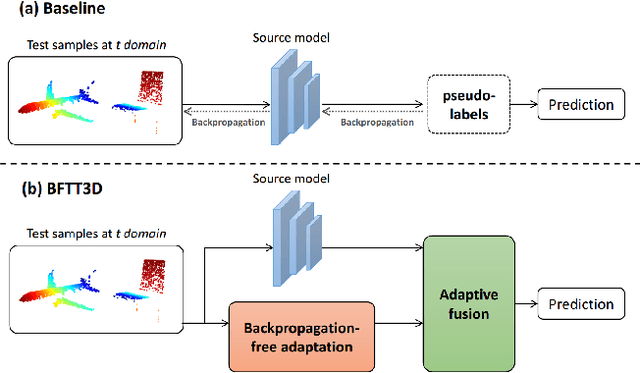

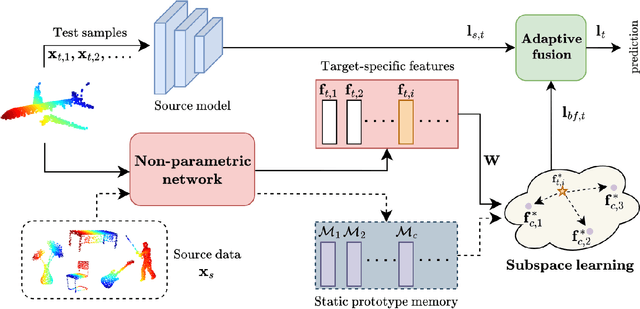

Abstract:Real-world systems often encounter new data over time, which leads to experiencing target domain shifts. Existing Test-Time Adaptation (TTA) methods tend to apply computationally heavy and memory-intensive backpropagation-based approaches to handle this. Here, we propose a novel method that uses a backpropagation-free approach for TTA for the specific case of 3D data. Our model uses a two-stream architecture to maintain knowledge about the source domain as well as complementary target-domain-specific information. The backpropagation-free property of our model helps address the well-known forgetting problem and mitigates the error accumulation issue. The proposed method also eliminates the need for the usually noisy process of pseudo-labeling and reliance on costly self-supervised training. Moreover, our method leverages subspace learning, effectively reducing the distribution variance between the two domains. Furthermore, the source-domain-specific and the target-domain-specific streams are aligned using a novel entropy-based adaptive fusion strategy. Extensive experiments on popular benchmarks demonstrate the effectiveness of our method. The code will be available at https://github.com/abie-e/BFTT3D.
ChatGPT-guided Semantics for Zero-shot Learning
Oct 18, 2023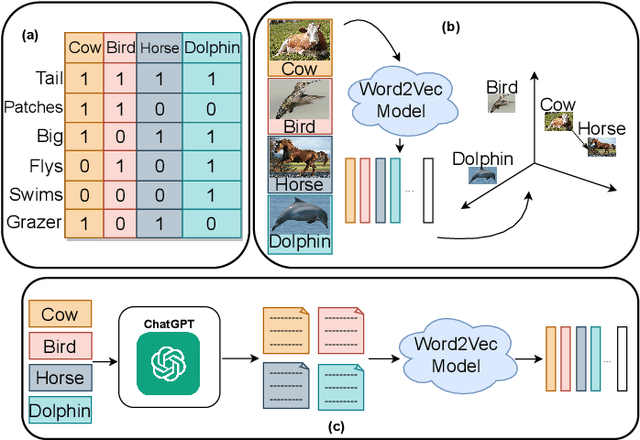
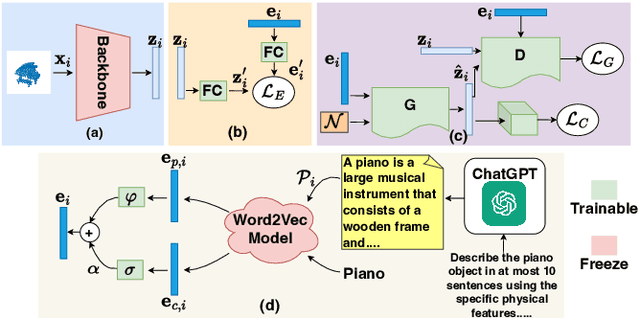

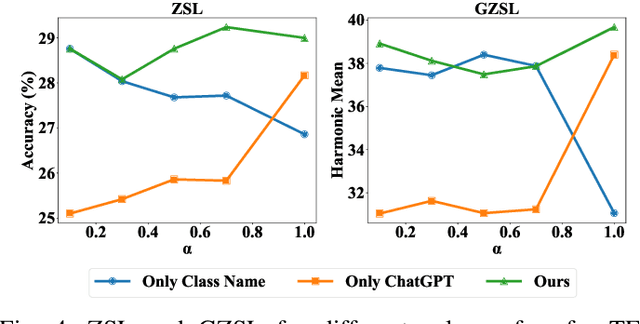
Abstract:Zero-shot learning (ZSL) aims to classify objects that are not observed or seen during training. It relies on class semantic description to transfer knowledge from the seen classes to the unseen classes. Existing methods of obtaining class semantics include manual attributes or automatic word vectors from language models (like word2vec). We know attribute annotation is costly, whereas automatic word-vectors are relatively noisy. To address this problem, we explore how ChatGPT, a large language model, can enhance class semantics for ZSL tasks. ChatGPT can be a helpful source to obtain text descriptions for each class containing related attributes and semantics. We use the word2vec model to get a word vector using the texts from ChatGPT. Then, we enrich word vectors by combining the word embeddings from class names and descriptions generated by ChatGPT. More specifically, we leverage ChatGPT to provide extra supervision for the class description, eventually benefiting ZSL models. We evaluate our approach on various 2D image (CUB and AwA) and 3D point cloud (ModelNet10, ModelNet40, and ScanObjectNN) datasets and show that it improves ZSL performance. Our work contributes to the ZSL literature by applying ChatGPT for class semantics enhancement and proposing a novel word vector fusion method.
Continual Test-time Domain Adaptation via Dynamic Sample Selection
Oct 05, 2023



Abstract:The objective of Continual Test-time Domain Adaptation (CTDA) is to gradually adapt a pre-trained model to a sequence of target domains without accessing the source data. This paper proposes a Dynamic Sample Selection (DSS) method for CTDA. DSS consists of dynamic thresholding, positive learning, and negative learning processes. Traditionally, models learn from unlabeled unknown environment data and equally rely on all samples' pseudo-labels to update their parameters through self-training. However, noisy predictions exist in these pseudo-labels, so all samples are not equally trustworthy. Therefore, in our method, a dynamic thresholding module is first designed to select suspected low-quality from high-quality samples. The selected low-quality samples are more likely to be wrongly predicted. Therefore, we apply joint positive and negative learning on both high- and low-quality samples to reduce the risk of using wrong information. We conduct extensive experiments that demonstrate the effectiveness of our proposed method for CTDA in the image domain, outperforming the state-of-the-art results. Furthermore, our approach is also evaluated in the 3D point cloud domain, showcasing its versatility and potential for broader applicability.
LumiNet: The Bright Side of Perceptual Knowledge Distillation
Oct 05, 2023
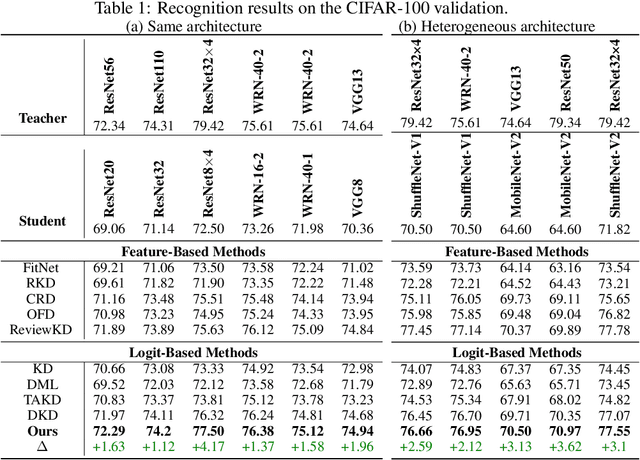

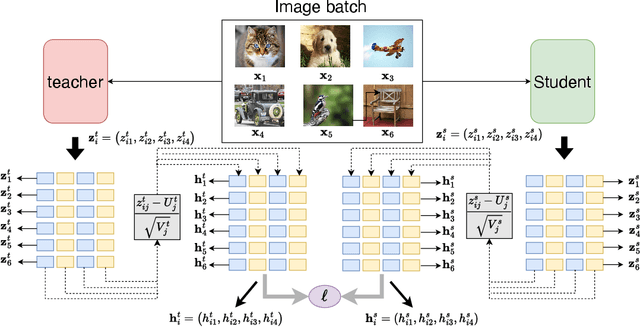
Abstract:In knowledge distillation research, feature-based methods have dominated due to their ability to effectively tap into extensive teacher models. In contrast, logit-based approaches are considered to be less adept at extracting hidden 'dark knowledge' from teachers. To bridge this gap, we present LumiNet, a novel knowledge-transfer algorithm designed to enhance logit-based distillation. We introduce a perception matrix that aims to recalibrate logits through adjustments based on the model's representation capability. By meticulously analyzing intra-class dynamics, LumiNet reconstructs more granular inter-class relationships, enabling the student model to learn a richer breadth of knowledge. Both teacher and student models are mapped onto this refined matrix, with the student's goal being to minimize representational discrepancies. Rigorous testing on benchmark datasets (CIFAR-100, ImageNet, and MSCOCO) attests to LumiNet's efficacy, revealing its competitive edge over leading feature-based methods. Moreover, in exploring the realm of transfer learning, we assess how effectively the student model, trained using our method, adapts to downstream tasks. Notably, when applied to Tiny ImageNet, the transferred features exhibit remarkable performance, further underscoring LumiNet's versatility and robustness in diverse settings. With LumiNet, we hope to steer the research discourse towards a renewed interest in the latent capabilities of logit-based knowledge distillation.
Prompt-guided Scene Generation for 3D Zero-Shot Learning
Sep 29, 2022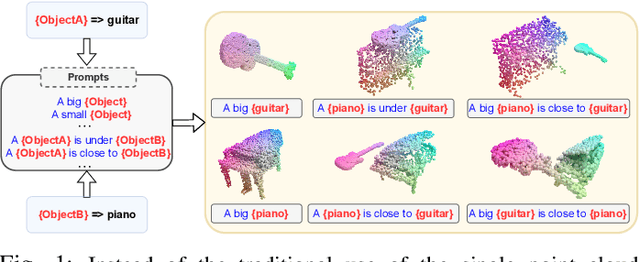

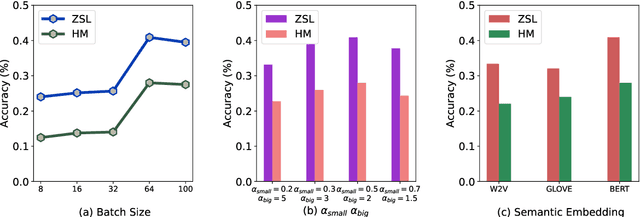

Abstract:Zero-shot learning on 3D point cloud data is a related underexplored problem compared to its 2D image counterpart. 3D data brings new challenges for ZSL due to the unavailability of robust pre-trained feature extraction models. To address this problem, we propose a prompt-guided 3D scene generation and supervision method that augments 3D data to learn the network better, exploring the complex interplay of seen and unseen objects. First, we merge point clouds of two 3D models in certain ways described by a prompt. The prompt acts like the annotation describing each 3D scene. Later, we perform contrastive learning to train our proposed architecture in an end-to-end manner. We argue that 3D scenes can relate objects more efficiently than single objects because popular language models (like BERT) can achieve high performance when objects appear in a context. Our proposed prompt-guided scene generation method encapsulates data augmentation and prompt-based annotation/captioning to improve 3D ZSL performance. We have achieved state-of-the-art ZSL and generalized ZSL performance on synthetic (ModelNet40, ModelNet10) and real-scanned (ScanOjbectNN) 3D object datasets.
 Add to Chrome
Add to Chrome Add to Firefox
Add to Firefox Add to Edge
Add to Edge